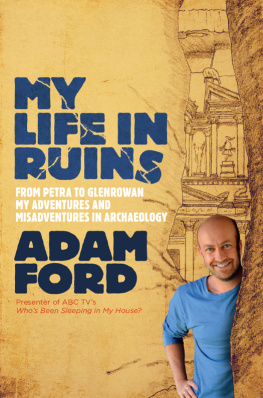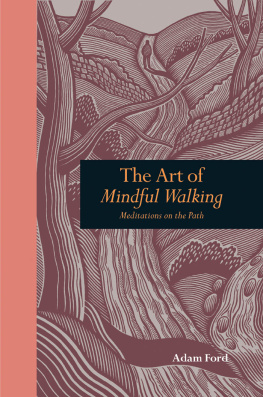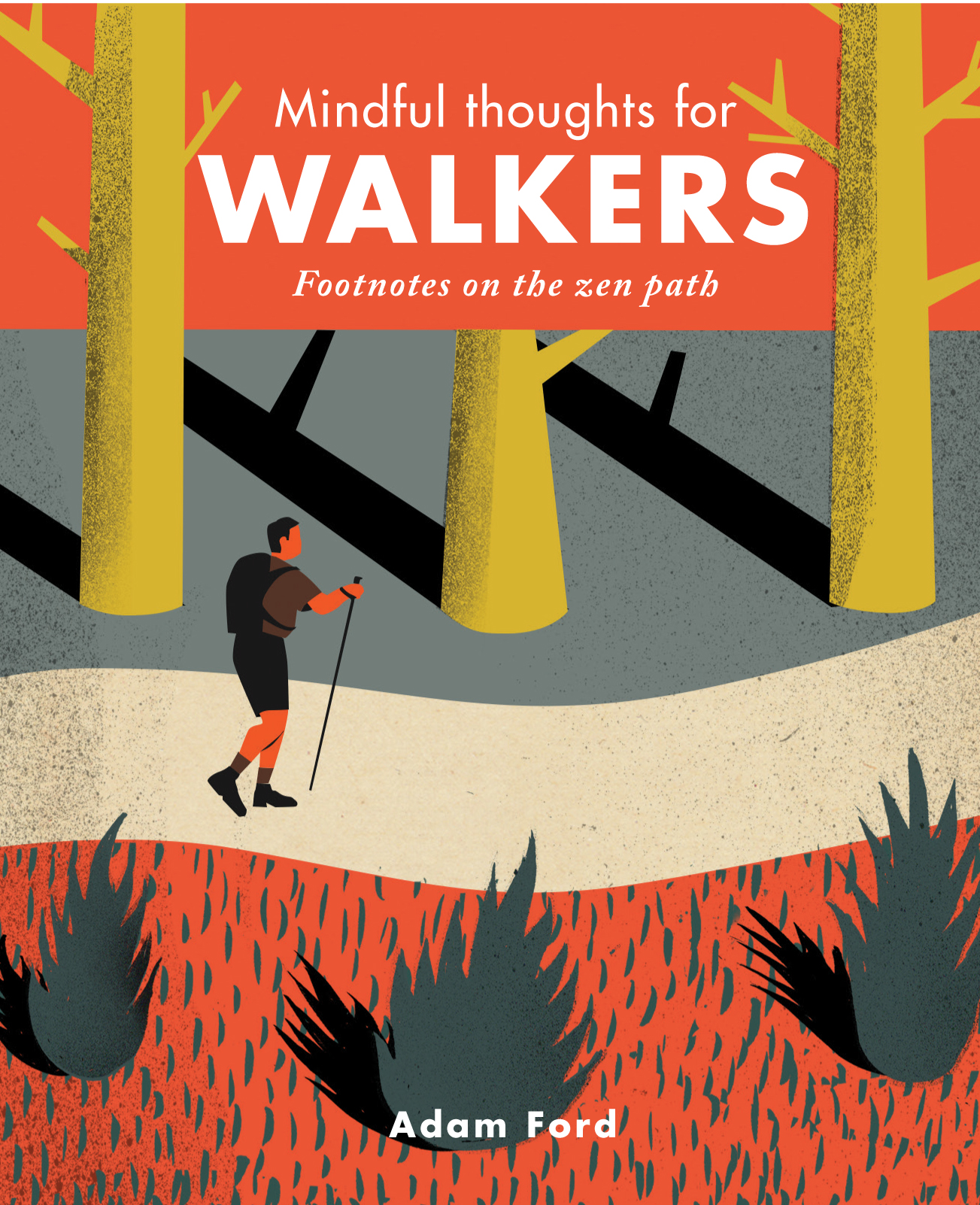Mindful thoughts for
WALKERS
Footnotes on the zen path
Adam Ford


INTRODUCTION
Walking the
Buddhist Path
One of the kindest things we can do for ourselves is to go for a good walk. It is one of the most natural activities in the world, exercising the body and stimulating the heart, while at the same time freeing the mind to become more open and alert. Like an over-tight muscle, the mind needs to be loosened before it can let go, so we are then able to enjoy the present moment and face reality. We return from a successful walk refreshed and clear-headed.

The purpose of this book is to explore how we may use walking as a way to increase our levels of awareness and to improve our conscious living to make the walk more enjoyable as we come to understand our place in the world of nature. The questions that lurk at the back of the mind can be faced: Who am I? Where have I come from? Where am I going? The walking may involve no more than a daily gentle stroll, or it may extend to that well-planned great hike that takes us beyond the horizon, following the course of a great river, or over mountain ranges and through remote forests.
Mindfulness is a way to keep in touch with reality, important for each of us individually, but also as members of a powerful and potentially destructive species. As an exercise, it has its roots both in human nature and in Buddhism. It is not always easy to be a human being; increasingly, we are in danger of living lives of fevered anxiety, concerned about the past and worried about the future, forgetting the life that is to be found here and now. We feel that in growing older we have lost something, that innocent ability in childhood to take unquestioning delight in simple things a ladybird, a toy or a gift.
Two and a half thousand years ago, the Buddha incorporated mindfulness into his teaching as a major element in the Eightfold Path and the perennial fight against ignorance. He encouraged his followers to become more attentive to their bodies, their feelings and their thoughts; to get to know and understand that bundle of worries that threatens to spoil life; to become more aware. He lived at a time of great change, when the old religions were being questioned, and taught a new spiritual way to explore life, one that was available to anyone, whatever their caste and whether they were religious or not.
An early image of the Buddha shows him sitting; one hand trails forward and is in touch with the ground. The original story is that the Buddha made a vow in a previous life to achieve enlightenment; in touching the ground, he is calling the earth to bear witness to the vow. He is meditating, but that does not mean he is away somewhere in the mind palace of his own head he is earthed like a lightning conductor to physical reality, to the present moment in the material and spiritual world.
One well-trodden way to practise mindfulness is to go for a good walk and to follow the Buddhas simple advice: When walking just walk.
The Burden
of Me
The Buddha taught mindfulness as part of the Eightfold Path, the Buddhist way of life, but it is just as valuable as a practice when separated from its religious origins. In a sense, mindfulness is no more Buddhist than the principles of loving-kindness or forgiveness are exclusively Christian.
The Buddha was aware that life in the sixth century BCE was full of problems, pain and suffering; apart from anything else, we all face old age, disease and death. The majority of people he observed were ill at ease with themselves and in need of guidance on how best to live their lives. Emotional ignorance about what it means to be a human being was as widespread then as it is today.
Traditional religion in his time was dominated by the divisive caste system, people allocated at birth to their place in a hierarchical society, and by a powerful priesthood who controlled the worship and festivals of the era. The Buddha wanted to give people something else; he offered them a path to follow that would not depend on any social system or priesthood but one in which they would be responsible for their own spiritual progress. Work out your own salvation with diligence were his last words to a friend.
The fundamental problem he identified is that of me. Each of us clings to an inflamed sense of self, a misguided focus, he believed, which is the cause of much of our pain. This comes as a challenging thought to Westerners who have grown up in a culture that lauds the individual, applauds self-confidence and bolsters the ego. We admire great personalities and reward them with continuous press coverage. But perhaps we have grown accustomed to thinking of the self in the wrong sort of way.
LEARNING TO ACCEPT WHO WE ARE
Who is it that is walking? We may be coping with negative feelings about ourselves, who we are and the way we have behaved, with memories that make us wince and worries that undermine us. But our feelings and thoughts come and go like storm clouds and it can be a great relief to realize that none of them are me.
Most of us will not want to go as far as the Buddha in this self-analysis, for he concluded that having stripped away everything, there is no such thing as the self (his goal was the remote and wordless state of bliss known as Nirvana). In the terms of modern neuroscience he would describe the self as a construct, an invention of the brain working to hold together all of our experience in a meaningful way. The eighteenth-century Scottish philosopher David Hume observed something similar, describing the human being as merely a bundle of sensations: For my part, when I enter most intimately into what I call myself, I always stumble on some particular perception or other, of heat or cold, light or shade, love or hatred, pain or pleasure. I never can catch myself at any time without a perception, and never can observe anything but the perception.
Whatever our view on the nature of me and we may prefer the language of soul when talking about our inner selves the Buddhist approach at least suggests that we can let go many of the things in our self-image that torment us; we have more inner freedom than we realized. We learn to accept who we are.
LET GO OF THINKING
Going for a good walk is a great way of letting go the burden of me. It gives us rhythmical time for sorting out our thoughts; for coming to terms with our humanity mortal, afflicted with doubt and feelings of guilt, vulnerable and often clouded by confusion. This does not mean that we walk away from our problems; it is more a case of getting them in proportion, seeing them for what they are and not allowing them to dominate us with guilt, worry or anxiety.
Here we must be careful, because when walking mindfully we should just walk, and rather than struggle with our various burdens, our first challenge is to let go of thinking. Just walk, one foot after the other. Later, things will begin to sort themselves out naturally, without effort. Let the head and the heart become clear without agonizing. Begin to look outwards; notice the sounds around you, the cooing of a pigeon or the whir of farm machinery in the distance; acknowledge the passer-by with a nod or a smile; stop and watch the flight of a butterfly. Consciously breathe the air and feel it giving life to the body.









